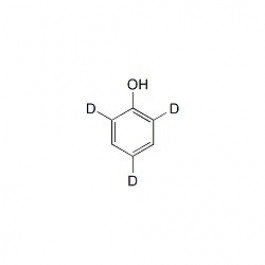New user? / Forgot your password?
0 Item | 0,00 €
Need NMR solvents or supplies? Click here and check out our ARMAR Isotopes catalog!
D3-2,4,6-Phenol
| Item number | 686554 |
| CAS | 7329-50-2 |
| Formula | C6H3D3O |
| Molecular weight | 97,13 g/mol |
| Quantity | 1X10MG |
| storage conditions | 20 °C |
Part of Product groups:
Product Variations:
Product | Catalog No./ CAS No. | Quantity | Price | |
|---|---|---|---|---|
 | 686554 | 1X10MG | ||
D3-2,4,6-Phenol solution |  | 686555 | 1X1ML | |
 | 677873 | 1X1000MG | Please log in. | |
D6-Phenol solution |  | 689891 | 1X5ML | |
 | 676001 | 1X1000MG | Please log in. | |
Phenol solution |  | 678056 | 1X1ML | Please log in. |
Phenol solution |  | 691870 | 1X10ML | Please log in. |



